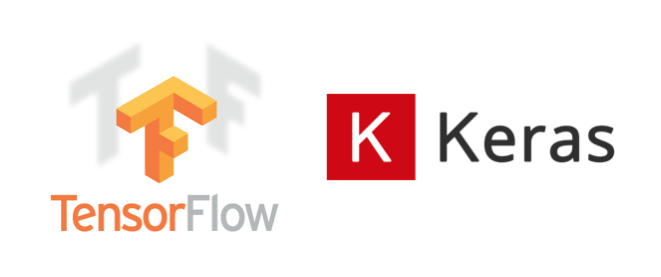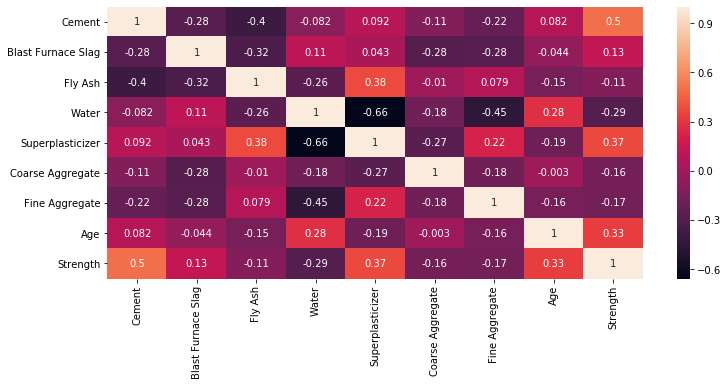Building Regression Model using Keras: Part 1
In part 1 of this notebook, a regression model will be built using Keras deep learning framework to predict the compressive strength of concrete, based on its ingredients. The model will be trained several times with different network properties such as the number of epochs and hidden layers, to increase the model accuracy.
Credit: IBM Cognitive Class
Building a Concrete Compressive Strength Model using Keras Framework

Concrete Ingredients:
- Cement
- Blast Furnace Slag
- Fly Ash
- Water
- Superplasticizer
- Coarse Aggregate
- Fine Aggregate
- Age
1. OBTAIN - Obtain Data from its Source.
First lets download the data and stored in pandas dataframe.
import pandas as pd
import numpy as np
import matplotlib.pyplot as plt
import seaborn as sns
url = 'https://s3-api.us-geo.objectstorage.softlayer.net/cf-courses-data/CognitiveClass/DL0101EN/labs/data/concrete_data.csv'
df = pd.read_csv(url)
df.head()
| Cement | Blast Furnace Slag | Fly Ash | Water | Superplasticizer | Coarse Aggregate | Fine Aggregate | Age | Strength | |
|---|---|---|---|---|---|---|---|---|---|
| 0 | 540.0 | 0.0 | 0.0 | 162.0 | 2.5 | 1040.0 | 676.0 | 28 | 79.99 |
| 1 | 540.0 | 0.0 | 0.0 | 162.0 | 2.5 | 1055.0 | 676.0 | 28 | 61.89 |
| 2 | 332.5 | 142.5 | 0.0 | 228.0 | 0.0 | 932.0 | 594.0 | 270 | 40.27 |
| 3 | 332.5 | 142.5 | 0.0 | 228.0 | 0.0 | 932.0 | 594.0 | 365 | 41.05 |
| 4 | 198.6 | 132.4 | 0.0 | 192.0 | 0.0 | 978.4 | 825.5 | 360 | 44.30 |
Let’s check the shape of the dataframe:
df.shape
(1030, 9)
It has 1030 rows and 9 columns.
2. SCRUB - Clean / Preprocess Data to Format that Machine Understand.
df.isnull().sum()
Cement 0
Blast Furnace Slag 0
Fly Ash 0
Water 0
Superplasticizer 0
Coarse Aggregate 0
Fine Aggregate 0
Age 0
Strength 0
dtype: int64
df.dtypes
Cement float64
Blast Furnace Slag float64
Fly Ash float64
Water float64
Superplasticizer float64
Coarse Aggregate float64
Fine Aggregate float64
Age int64
Strength float64
dtype: object
The data looks very clean; no missing data and all data is in numerical form.
Nothing much here, lets move to our next step!
3. EXPLORE - Find Significant Patterns and Trends using Statistical Method.
df.describe()
| Cement | Blast Furnace Slag | Fly Ash | Water | Superplasticizer | Coarse Aggregate | Fine Aggregate | Age | Strength | |
|---|---|---|---|---|---|---|---|---|---|
| count | 1030.000000 | 1030.000000 | 1030.000000 | 1030.000000 | 1030.000000 | 1030.000000 | 1030.000000 | 1030.000000 | 1030.000000 |
| mean | 281.167864 | 73.895825 | 54.188350 | 181.567282 | 6.204660 | 972.918932 | 773.580485 | 45.662136 | 35.817961 |
| std | 104.506364 | 86.279342 | 63.997004 | 21.354219 | 5.973841 | 77.753954 | 80.175980 | 63.169912 | 16.705742 |
| min | 102.000000 | 0.000000 | 0.000000 | 121.800000 | 0.000000 | 801.000000 | 594.000000 | 1.000000 | 2.330000 |
| 25% | 192.375000 | 0.000000 | 0.000000 | 164.900000 | 0.000000 | 932.000000 | 730.950000 | 7.000000 | 23.710000 |
| 50% | 272.900000 | 22.000000 | 0.000000 | 185.000000 | 6.400000 | 968.000000 | 779.500000 | 28.000000 | 34.445000 |
| 75% | 350.000000 | 142.950000 | 118.300000 | 192.000000 | 10.200000 | 1029.400000 | 824.000000 | 56.000000 | 46.135000 |
| max | 540.000000 | 359.400000 | 200.100000 | 247.000000 | 32.200000 | 1145.000000 | 992.600000 | 365.000000 | 82.600000 |
plt.figure(figsize=(12, 5))
correlation_matrix = df.corr()
sns.heatmap(correlation_matrix, annot=True)
plt.show()

As our objective is mainly to build the model, we will just touch a few in this EDA (exploratory data analysis) section.
4. MODEL - Construct Model to Predict and Forecast.
The part where the magic happens.
Split Data to Predictors and Target
X = df.iloc[:,:-1]
X.head()
| Cement | Blast Furnace Slag | Fly Ash | Water | Superplasticizer | Coarse Aggregate | Fine Aggregate | Age | |
|---|---|---|---|---|---|---|---|---|
| 0 | 540.0 | 0.0 | 0.0 | 162.0 | 2.5 | 1040.0 | 676.0 | 28 |
| 1 | 540.0 | 0.0 | 0.0 | 162.0 | 2.5 | 1055.0 | 676.0 | 28 |
| 2 | 332.5 | 142.5 | 0.0 | 228.0 | 0.0 | 932.0 | 594.0 | 270 |
| 3 | 332.5 | 142.5 | 0.0 | 228.0 | 0.0 | 932.0 | 594.0 | 365 |
| 4 | 198.6 | 132.4 | 0.0 | 192.0 | 0.0 | 978.4 | 825.5 | 360 |
y = df.iloc[:,-1]
y.head()
0 79.99
1 61.89
2 40.27
3 41.05
4 44.30
Name: Strength, dtype: float64
Save number of feature columns, n_cols to use later in model development.
n_cols = X.shape[1]
n_cols
8
Importing SKLEARN and KERAS Libraries
from sklearn.model_selection import train_test_split
from sklearn.metrics import mean_squared_error
from sklearn.metrics import r2_score
import keras
from keras.models import Sequential
from keras.layers import Dense
Using TensorFlow backend.
Building the Model
A. BASELINE MODEL
Network Properties:
- Hidden Layer: 1
- Nodes: 10
- Activation Function: ReLU
- Optimizer: Adam
- Loss Function: Mean Squared Error
- Epochs: 50
mse_A = []
r2_A = []
for i in range(50):
#Split Data to Train and Test Set
X_train, X_test, y_train, y_test = train_test_split(X, y, test_size = 0.3)
#Create model
model = Sequential()
model.add(Dense(10, activation='relu', input_shape=(n_cols,)))
model.add(Dense(1))
#Compile model
model.compile(optimizer='adam', loss='mean_squared_error')
#fit the model
model.fit(X_train, y_train, epochs=50, verbose=0)
#predict output on test set
y_pred = model.predict(X_test)
mse_A.append(mean_squared_error(y_test, y_pred))
r2_A.append(r2_score(y_test, y_pred))
print('mse_Mean: {:.2f}'.format(np.mean(mse_A)))
print('mse_StdDev: {:.2f}'.format(np.std(mse_A)))
mse_Mean: 421.94
mse_StdDev: 595.59
print('R^2_Mean: {:.2f}'.format(np.mean(r2_A)))
print('R^2_StdDev: {:.2f}'.format(np.std(r2_A)))
R^2_Mean: -0.54
R^2_StdDev: 2.20
B. MODEL WITH NORMALIZED DATA
Network Properties:
- Hidden Layer: 1
- Nodes: 10
- Activation Function: ReLU
- Optimizer: Adam
- Loss Function: Mean Squared Error
- Epochs: 50
Model is retrain with normalized data.
X_norm = (X - X.mean()) / X.std()
X_norm.head()
| Cement | Blast Furnace Slag | Fly Ash | Water | Superplasticizer | Coarse Aggregate | Fine Aggregate | Age | |
|---|---|---|---|---|---|---|---|---|
| 0 | 2.476712 | -0.856472 | -0.846733 | -0.916319 | -0.620147 | 0.862735 | -1.217079 | -0.279597 |
| 1 | 2.476712 | -0.856472 | -0.846733 | -0.916319 | -0.620147 | 1.055651 | -1.217079 | -0.279597 |
| 2 | 0.491187 | 0.795140 | -0.846733 | 2.174405 | -1.038638 | -0.526262 | -2.239829 | 3.551340 |
| 3 | 0.491187 | 0.795140 | -0.846733 | 2.174405 | -1.038638 | -0.526262 | -2.239829 | 5.055221 |
| 4 | -0.790075 | 0.678079 | -0.846733 | 0.488555 | -1.038638 | 0.070492 | 0.647569 | 4.976069 |
mse_B = []
r2_B = []
for i in range(50):
#Split Data to Train and Test Set
X_train, X_test, y_train, y_test = train_test_split(X_norm, y, test_size = 0.3)
#Create model
model = Sequential()
model.add(Dense(10, activation='relu', input_shape=(n_cols,)))
model.add(Dense(1))
#Compile model
model.compile(optimizer='adam', loss='mean_squared_error')
#fit the model
model.fit(X_train, y_train, epochs=50, verbose=0)
#predict output on test set
y_pred = model.predict(X_test)
mse_B.append(mean_squared_error(y_test, y_pred))
r2_B.append(r2_score(y_test, y_pred))
print('mse_Mean: {:.2f}'.format(np.mean(mse_B)))
print('mse_StdDev: {:.2f}'.format(np.std(mse_B)))
mse_Mean: 372.05
mse_StdDev: 104.26
print('R^2_Mean: {:.2f}'.format(np.mean(r2_B)))
print('R^2_StdDev: {:.2f}'.format(np.std(r2_B)))
R^2_Mean: -0.32
R^2_StdDev: 0.37
C. MODEL WITH 100 EPOCHS
Network Properties:
- Hidden Layer: 1
- Nodes: 10
- Activation Function: ReLU
- Optimizer: Adam
- Loss Function: Mean Squared Error
- Epochs: 100
Model is retrained with 100 epochs.
mse_C = []
r2_C = []
for i in range(50):
#Split Data to Train and Test Set
X_train, X_test, y_train, y_test = train_test_split(X_norm, y, test_size = 0.3)
#Create model
model = Sequential()
model.add(Dense(10, activation='relu', input_shape=(n_cols,)))
model.add(Dense(1))
#Compile model
model.compile(optimizer='adam', loss='mean_squared_error')
#fit the model
model.fit(X_train, y_train, epochs=100, verbose=0)
#predict output on test set
y_pred = model.predict(X_test)
mse_C.append(mean_squared_error(y_test, y_pred))
r2_C.append(r2_score(y_test, y_pred))
print('mse_Mean: {:.2f}'.format(np.mean(mse_C)))
print('mse_StdDev: {:.2f}'.format(np.std(mse_C)))
mse_Mean: 162.55
mse_StdDev: 16.92
print('R^2_Mean: {:.2f}'.format(np.mean(r2_C)))
print('R^2_StdDev: {:.2f}'.format(np.std(r2_C)))
R^2_Mean: 0.41
R^2_StdDev: 0.05
D. MODEL WITH 3 HIDDEN LAYERS
Network Properties:
- Hidden Layers: 3
- Nodes: 10
- Activation Function: ReLU
- Optimizer: Adam
- Loss Function: Mean Squared Error
- Epochs: 100
Model is retrained with 3 hidden layers.
mse_D = []
r2_D = []
for i in range(50):
#Split Data to Train and Test Set
X_train, X_test, y_train, y_test = train_test_split(X_norm, y, test_size = 0.3)
#Create model
model = Sequential()
model.add(Dense(10, activation='relu', input_shape=(n_cols,)))
model.add(Dense(10, activation='relu'))
model.add(Dense(10, activation='relu'))
model.add(Dense(1))
#Compile model
model.compile(optimizer='adam', loss='mean_squared_error')
#fit the model
model.fit(X_train, y_train, epochs=100, verbose=0)
#predict output on test set
y_pred = model.predict(X_test)
mse_D.append(mean_squared_error(y_test, y_pred))
r2_D.append(r2_score(y_test, y_pred))
print('mse_Mean: {:.2f}'.format(np.mean(mse_D)))
print('mse_StdDev: {:.2f}'.format(np.std(mse_D)))
mse_Mean: 112.99
mse_StdDev: 187.54
print('R^2_Mean: {:.2f}'.format(np.mean(r2_D)))
print('R^2_StdDev: {:.2f}'.format(np.std(r2_D)))
R^2_Mean: 0.59
R^2_StdDev: 0.66
5. iNTERPRET - Analyze and Interpret Model
Comparing all evaluation metrics
from IPython.display import HTML, display
import tabulate
tabletest = [['STEPS','MSE: Mean','MSE: StdDev','R^2: Mean','R^2: StdDev'],
['A', round(np.mean(mse_A),2), round(np.std(mse_A),2), round(np.mean(r2_A),2), round(np.std(r2_A),2)],
['B', round(np.mean(mse_B),2), round(np.std(mse_B),2), round(np.mean(r2_B),2), round(np.std(r2_B),2)],
['C', round(np.mean(mse_C),2), round(np.std(mse_C),2), round(np.mean(r2_D),2), round(np.std(r2_C),2)],
['D', round(np.mean(mse_D),2), round(np.std(mse_D),2), round(np.mean(r2_D),2), round(np.std(r2_D),2)]]
display(HTML(tabulate.tabulate(tabletest, tablefmt='html')))
| STEPS | MSE: Mean | MSE: StdDev | R^2: Mean | R^2: StdDev |
| A | 421.94 | 595.59 | -0.54 | 2.2 |
| B | 372.05 | 104.26 | -0.32 | 0.37 |
| C | 162.55 | 16.92 | 0.59 | 0.05 |
| D | 112.99 | 187.54 | 0.59 | 0.66 |
From the results above, we can clearly see that by applying:
- Data Normalization,
- Increasing Epochs,
- and Increasing Hidden Layers
the mean of MSE has gone down, while the mean of R^2 has gone up indicating that the model accuracy is getting better.

